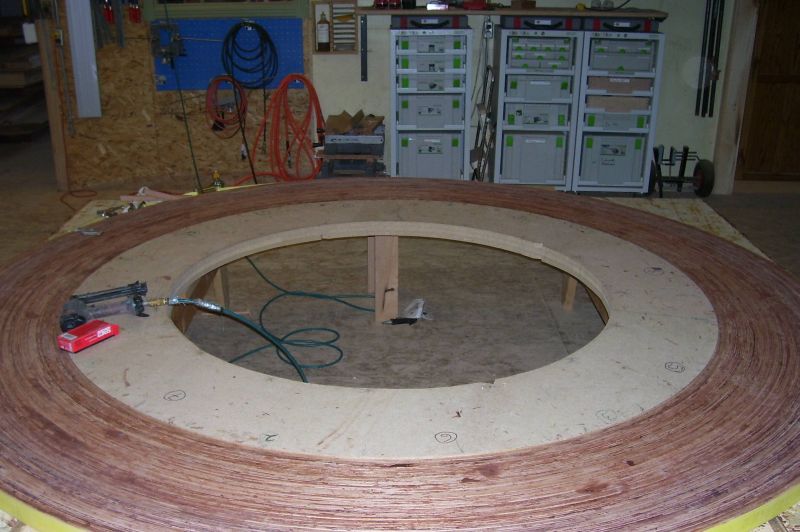Question
I have a client who is requesting a feasibility assessment on a couple of ipe bench seats. They are curved with a radius of about eleven feet. The arc length is around seventeen feet long. The architect has drawn them as basically 2 x 4's turned up on edge and bolted down to a steel plate. The seats would be about 21" wide.
I've never tried to bend ipe, though I've read online that people have had some success with it, especially if it's cut into 1/4" laminations and glued with epoxy. I was hoping that with an 11 foot radius, a 2 x 4 might be able to be bolted into submission without breaking, and thereby avoid gluing. Any input from someone with more experience would be greatly appreciated.
Forum Responses
(Architectural Woodworking Forum)
From contributor J:
I was taught to attempt a bend with the largest possible piece, then work my way down to a piece that would actually bend to the desired radius. Not a great answer, as I have never bent ipe, but it is an approach that has worked for me with other wood species.
I have spent the last two summers repairing the deck. Every edge glued joint and every lamination has failed, caused by a combination of wood warp and glue failure. I have been forced to use hundreds of screws, plugs, and tinted wood epoxy to fill the cracks and bring the deck somewhat back into submission.
Keep this in mind when you think about laminating ipe that's going to be outdoors. I don't know if I could have used a better glue, or if my Washington state winters are just too much to handle, but I wouldn't do it again.
I would spend my energy on working up a very feasible alternate to propose back to the client and architect. The fact that they request a feasibility study shows they are looking to a professional for answers, so it is your opportunity to put out what you know. Ipe` was (likely) mentioned not because of intensive experience or knowledge on their part - they just know of it and know it is good for exterior use. Iroko ("Brazilian teak") is one option that can be resawn and will take epoxy well. H. mahogany is another. And find something better than steel for the base - it won't last as long as good woodwork. The base also needs to drain so the wood won't sit in water.
Ipe will check and crack in service, so that will affect the integrity of the lam. I found that using flat sawn wood is much better than the quartered ribbon stripe for resistance of checking. You probably can easily get away with 3/8 thick strips. The trick to gluing is not to glue to the surface right out of the planer. It is too smooth and glazed. Belt sand it or wide belt it to get a rough surface prior to gluing. This method has worked for me in the Northwest weather.
As mentioned, taking laminations straight out of the planer is prone to epoxy failures. We have seen this with mahogany, and with maple it is almost guaranteed. Ipe is going to be even worse than hard maple. I would run the laminates through a thickness sander with a brand new 60 grit belt.
I second the comments from contributor V. However, any of the ipe species will work if steamed. As mentioned, why use ipe, as there are other, easier species?
You will get better bending if using q-sawn.
Note the comment about epoxy joints; they must be thick glue joints compared to PVA. If exposed outside, epoxy is deteriorated by UV unless you use UV resistant adhesive.
Ipe will develop cracks as it weathers.
I wanted to build the bench in segments from edge glued boards with slightly rounded joints at the segments and possibly unglued at the joint. The PM on the project is a former wooden boat builder - this was his idea and the homeowner liked it. Like one poster suggested, this is “non-warranted work.” I have no experience building a full circle lamination like this and my big concern is what happens when the MC changes and the ring starts growing? My segment idea might have been worse for the wood movement.
The full circle presents a few challenges over the typical open end curve lamination. We settled on 5mm thick laminations. Our method is like contributor P's - just run it down till it works easy. With your radius, 3/8 or even thicker should be possible. The length cuts for each 2 piece ring have to be made as we’re laminating. We pin nail the strips on, then band clamp after 6 rings. After we started, my coworker suggested if we do this again to build the form to the outside and work in. I think it would work better and you could do the whole thing without clamping by springing each piece in. Easier to get the length cuts also.
For glue we are using resorcinol from CP Adhesives. We started with Dap resorcinol from the local hardware store. The CP glue is a lot better and less expensive. Over $200 of glue in this bench! Final surface on the strips was 80 grit on the WBS with a steel drum. The marine industry probably has better waterproof glues now but I have always had good luck with resorcinol. Time will tell if this works…

I used West Epoxy on my sailboat and it is still together, so I do not think that even if the adhesive has fillers added, it is a problem. It seems to be working well. Incidentally, I did add wood dust filler myself when making an epoxy fillet joint.